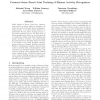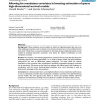962 search results - page 83 / 193 » Redundancy based feature selection for microarray data |
108
click to vote
PAMI
2011
14 years 4 months ago
2011
—In this work, we investigate eye movement analysis as a new sensing modality for activity recognition. Eye movement data were recorded using an electrooculography (EOG) system. ...
IJCAI
2007
14 years 11 months ago
2007
Given sensors to detect object use, commonsense priors of object usage in activities can reduce the need for labeled data in learning activity models. It is often useful, however,...
BMCBI
2008
14 years 10 months ago
2008
Background: When predictive survival models are built from high-dimensional data, there are often additional covariates, such as clinical scores, that by all means have to be incl...
BMCBI
2006
14 years 10 months ago
2006
Affymetrix microarrays have become a standard experimental platform for studies of mRNA expression profiling. Their success is due, in part, to the multiple oligonucleotide featur...
APIN
2010
14 years 10 months ago
2010
Abstract. This paper introduces a robust variant of AdaBoost, cwAdaBoost, that uses weight perturbation to reduce variance error, and is particularly effective when dealing with da...


